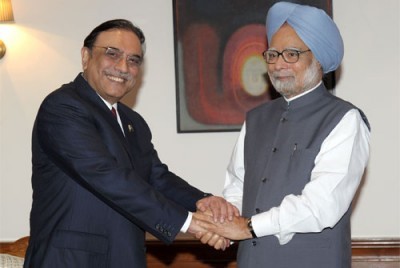 Comparing countries to animals is an absorbing pastime for foreign policy analysts to discover their essential character. It is, therefore, no accident that the US has chosen the eagle to be its national symbol to emphasize its aggressive, risk-taking nature. The erstwhile Soviet Union, now Russia, identified itself with the bear, which hugs what it seizes securely to itself. During the heyday of the Empire, the British lion - king of the forest - symbolised its power, which is intriguing since that feline is not indigenous to the British Isles. Nearer home, animal allegories have sought to capture the basic character of China and India. China conjures up conflicting images of a cuddly panda and fire-breathing dragon, while India has been compared to the prickly porcupine or self-preening peacock or lumbering elephant.
Comparing countries to animals is an absorbing pastime for foreign policy analysts to discover their essential character. It is, therefore, no accident that the US has chosen the eagle to be its national symbol to emphasize its aggressive, risk-taking nature. The erstwhile Soviet Union, now Russia, identified itself with the bear, which hugs what it seizes securely to itself. During the heyday of the Empire, the British lion - king of the forest - symbolised its power, which is intriguing since that feline is not indigenous to the British Isles. Nearer home, animal allegories have sought to capture the basic character of China and India. China conjures up conflicting images of a cuddly panda and fire-breathing dragon, while India has been compared to the prickly porcupine or self-preening peacock or lumbering elephant.
In this milieu, Michael Krepon’s characterisation of the India-Pakistan nuclear imbroglio in terms of the Aesopian hare-tortoise fable greatly overstates the case. Krepon argues that “India’s nuclear weapons program is moving steadily forward without great exertion. The tortoise will win this race, and could quicken its pace. But the hare continues to run fast, because nuclear weapons are a sign of strength amidst growing domestic weaknesses and because it can’t keep up with the growth of India’s conventional military programs.” This is not quite accurate, since it must also be appreciated that the strategic direction of India’s military nuclear program has uncompromisingly been directed against China and, incidentally, against Pakistan. In other words, nuclear weapons are primarily required by India to establish strategic parity with China, and secondarily, to deter Pakistan’s intransigence. Pakistan’s nuclear program, however, is essentially intended to counter its conventional forces inferiority vis-à-vis India.
Currently, both countries hold around 80-100 nuclear weapons in their stockpiles. Despite routine pledges to maintain a minimal deterrent, the size of these stockpiles has doubled over the last decade. Both countries also possess cruise missiles, and are seeking nuclear armed submarines to ensure the survivability of their deterrent, provide second strike capability, and strengthen their deterrent postures. Pakistan, in fact, has imbued nuclear weapons with magical properties; they can deter India, and provide a sense of equality with its seven-times-larger neighbour that is fast becoming the third largest economic power in the world. Nuclear weapons also provide it with strategic reassurance, however illusory, in dealing with the US. Nothing, therefore, infuriates Pakistanis more than suggestions that the US should gain control over or ‘takes out’ Pakistan’s nuclear arsenal in defined circumstances.
Krepon also draws attention to the fact that Pakistan’s nuclear policy, and, for that matter its defence, as well as its Kashmir and India policy are strictly controlled by the Pakistan Army, with civilians playing a peripheral role in the decision-making apparatus. He then draws attention to the quantitative and qualitative nuclear arms race proceeding in South Asia, with obvious dangers for its strategic stability. Unfortunately, he has no plausible solutions to proffer about how India should configure the size and structure of its nuclear arsenal to meet the threat from China without inviting a reaction from Pakistan. In other words, how could arms race stability be sought in a triangular nuclear scenario, which is unique in the international security system, and has no guiding precedent? Unstated here is his belief that India faces no nuclear danger from China; hence, it is excessive for India to conjure up a non-existent nuclear threat from China to justify its enlarging the range of its delivery capabilities, and making other attempts to sophisticate its nuclear arsenal.
He then suggests that: “The safest route to reduce nuclear dangers on the subcontinent is through concerted, top-down efforts to improve relations between Pakistan and India. The surest way to do so is by greatly increasing cross-border trade. Leaders in both countries have endorsed this course of action, but underlings are moving slowly in the run-up to national elections.” He might have added the need to liberalise the visa regime, and promoting reciprocal visits of special interest groups like students, media persons, legislators, professional groups and so on to create constituencies in both countries that would develop a mutual interest in friendly bilateral relations. These are tired old beliefs, and have often been made before. Regrettably, these eminently sensible suggestions have wrecked on the rocks of official obduracy and obstruction. Why? In truth, the political leadership and, in the background, the military and intelligence services in India and Pakistan have no interest in permitting such confidence-building measures to flourish and erode their institutionalised negativism.
Unless Krepon can find a better solution to these problems, his well-meaning ideas to insulate the nuclear entanglement between India and Pakistan from disaster are not going to succeed. Of course, the disaster is of primary consequence for the two South Asian adversaries, who need to be aware of and address the dangers to their own survival.
Courtesy : Institute of Peace and Conflict Studies (http://www.ipcs.org)